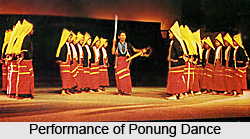 Ponung dance is a popular and the most common folk art form practiced in the Arunachal Pradesh state of India. It is traditionally the folk dance of the Adis community who are known for their rich cultural way of living. The Adi village and its tribal people have gained popularity due to this very Ponung, which is quite a lively dance accompanied with mesmerising songs. It is exhibited during the festival that is celebrated before the harvesting. This dance is performed on all-important and auspicious occasions. The performance draws an impressive number of tourists from various parts of the country.
Ponung dance is a popular and the most common folk art form practiced in the Arunachal Pradesh state of India. It is traditionally the folk dance of the Adis community who are known for their rich cultural way of living. The Adi village and its tribal people have gained popularity due to this very Ponung, which is quite a lively dance accompanied with mesmerising songs. It is exhibited during the festival that is celebrated before the harvesting. This dance is performed on all-important and auspicious occasions. The performance draws an impressive number of tourists from various parts of the country.
Purpose of Ponung Dance
Entertainment is not the only reason for the performance of Ponung dance. The purpose of this dance festival is seeking a good harvest and welfare of the village community.
Performance of Ponung Dance
Ponung is an exclusive women dance, which is performed in a group. It can be performed by the young married women as well as young girls.
The dance performance is led by a Miri, who is a man adept in mythical songs about the origin of paddy and other crops. All the girls dance in a circle by holding each other. Occasionally, the dancers stretch their hands over each other`s shoulders. Then the Miri dances and sings in the centre of the circle. He sings the `abhanga` written on the origin of paddy, at the time of dancing. He holds aloft and shakes a sword like musical instrument called `Yoksha`. No other instrument accompanies this traditional dance form. While singing the mythical songs by the Miri, the iron discs that are fitted loosely in the hilt of the sword are rattled. After initiating the singing, the female dancers perform rhythmically at a slow pace, on this background, singing in a chorus.
Costume of Ponung Dance
The dancers clad themselves in ethnic dresses which add colour to their performance. The costume mainly comprises of a long skirt and kurti. The skirt and the kurti are generally designed using the basic colours namely black, red and blue. They also adorn themselves with traditional heavy jewelleries like necklace and ear ring. They neatly tie their hair in a bun. Occasionally, the participants also wear an ethnic headdress.



















